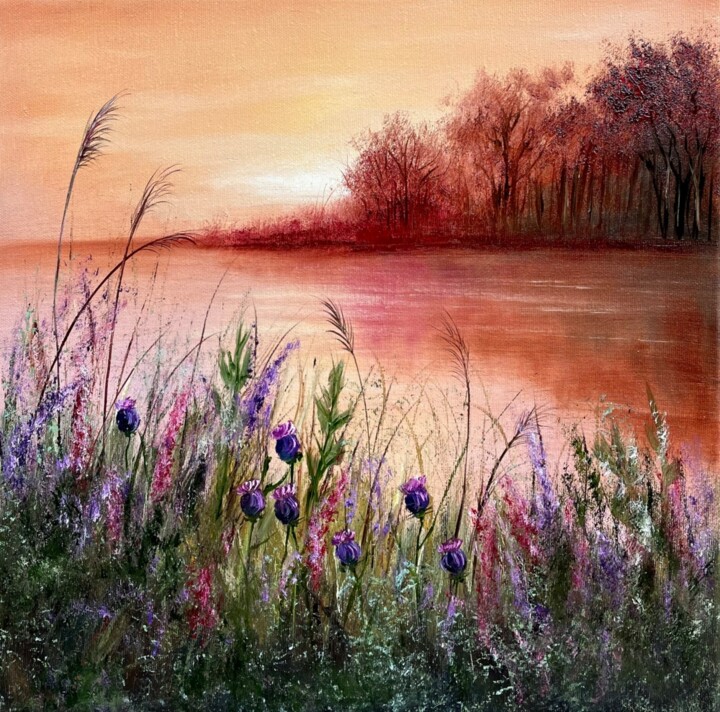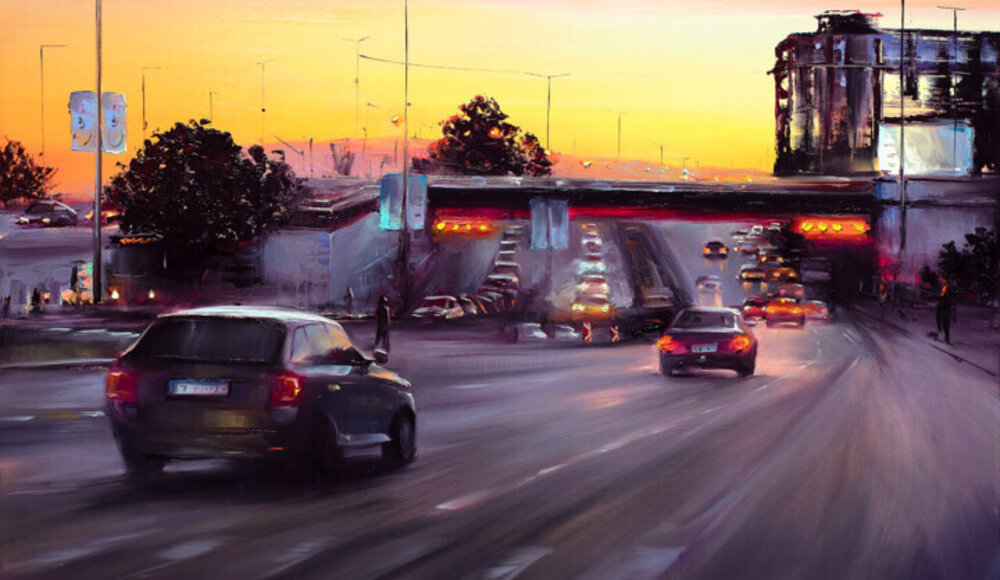 WARM SUNSET OVER THE CITY (2023)Painting by Bozhena Fuchs.
WARM SUNSET OVER THE CITY (2023)Painting by Bozhena Fuchs.
The masters of light: Turner and Monet
I begin with a question that is little exploited, overlooked, and often taken for granted, both in general terms and within the analysis of many masterpieces of art history, where the titles of the works themselves often resolve dilemmas degrees, preventing critics from further investigating the nature, as well as the identity, of what is depicted. In this specific case I want to refer to the works, which, in case they do not bear an explicit titling referring to the subject, could immortalize, either the phenomenon of sunrise, or the related phenomenon of sunset. This problem of identification, which will arise here for only some of the works that will be investigated, leads me to teach you a kind of trick, by which it might be possible to distinguish the two manifestations within a composition. In fact, sunrise would seem to bring more bright and bluish skies, while sunset, on the other hand, would bring about the advent of greater darkness, marked mainly by reddish hues. Despite this clarification, it still remains difficult, in some cases, to distinguish with certainty between the two related phases of the day, so much so that I have no choice but to set aside the problem of identifying the subject matter in order to devote myself to the account of views and landscapes by the two best-known masters of light, namely Turner and Monet, artists whose work, primarily focused on the rendering of light and atmospheric data, was often devoted to immortalizing the manifestation, or disappearance, of the sun. Starting with the elder of the two, Turner, known for taking landscape painting to new and unprecedented heights, distinguished himself for his masterful use of light, understood as a means of charging scenes with an intense emotionality, capable of attributing to the painting a higher level of expression, aimed at alluding directly to manifestations of the divine, ready to soothe, or spevent, human beings. What has just been described finds manifestation, precisely in this last negative meaning of fear, in the masterpiece titled The Slave Ship (1840), which, perhaps set at sunset, immortalizes a boat in the grip of the destructive force of the waters, as it is intent on fleeing away from the area in question, losing, however, on its way a multitude of men, who try to resist the onset of hungry fish and monstrous creatures. Giving voice to their cries of pain, however, are the marked colors of the palette, ready to emphasize the devastating power of nature as well as the sad human helplessness. In addition to The Nigger Ship there are other masterpieces of the master in question, aimed at depicting the moments of the day of our interest, such as, for example, Sunrise with sea monsters (1845), Sunset (1830), The Valiant Temeraire (1839), etc., although the culmination of experimentation in this regard is reached of the artist in The Light and the Color (Goethe's Theory) (1843), a painting in which the apex of his studies on light and color is also realized. The latter are realized within an indeterminate subject, perhaps caught in the sunset, in which the forms, now dematerialized, are replaced by the presence of color, light and pictorial matter, marked by a centrifugal motion, aimed at containing, in part, subjects on the verge of identification. In any case, such "abstract" triumph was conceived to give form to the well-known and "concrete" event of the Universal Flood, a cataclysm, which, taken from Genesis and capable of submerging the entire globe, highlights Turner's most beloved ambivalence, namely that peculiar conception of a "bipolar" nature, to be understood as a creative and destructive force at the same time. Finally, regarding the aforementioned experiments on light, the work stems from the assimilation of Goethe's scientific investigations, particularly the Theory of Color, according to which it is light that generates chromatics, a fact that prompted the artist to search for the most exuberant luminous effects to be achieved through the use of color.
 BLOCK ISLAND SUNRISE (2019)Painting by Roy Wrenn.
BLOCK ISLAND SUNRISE (2019)Painting by Roy Wrenn.
 BLISS (2023)Painting by Eva Volf.
BLISS (2023)Painting by Eva Volf.
At this point, how is it possible to move from Turner to Monet? Easy! We simply need to link some traits of the former's Romanticism with the latter's Impressionist peculiarities, an action that is afforded to us by the fact that Turner, like later Impressionism, innovatively paid attention to en plein air painting, immortalizing his landscapes in notebooks, as well as placing color at the center of his artistic quest. In any case, it is worth highlighting that, unlike the Impressionists, the English painter did not want to give back to the viewer a faithful vision of nature, but to shape the emotions aroused by the spectacle of incredible events in creation. Speaking of Monet, it is impossible not to make reference to Impression, Sunrise (1874), a masterpiece depicting the orange sunrise in the port of Le Havre, where the fog and the opaque atmosphere of twilight suggest a suggestion, or rather an impression, of reality, which is a substitute for the more traditional and meticulous description of nature. Precisely such peculiarities, can again be encapsulated and recognized in the same term impression, which, after giving title to the work in question, also extended its meaning to the movement of the same name, of which additional Monet sunsets are also part, such as, for example: San Giorgio Maggiore at Dusk. The latter oil of 1908, capturing the island si San Giorgio Maggiore in Venice, is part of a series of works of the same subject, aimed at capturing it at various times of the day and, consequently, from different chromatic-atmospheric points of view. Having now finished the romantic-impressionist story, my art-historical narrative, regarding the sunset, or sunrise, continues through the work of some of Artmajeur's artists, such as: Bozhena Fuchs, Otto Frühwach and Svetlana Kostina.
 BEAUTIFUL SUNRISE (2023)Painting by Tanja Frost.
BEAUTIFUL SUNRISE (2023)Painting by Tanja Frost.
 SUNRISE. ALBA. (2020)Painting by Achille Chiarello.
SUNRISE. ALBA. (2020)Painting by Achille Chiarello.
Bozhena Fuchs: Meeting the sun
The first interpretation of Fuchs' navy is provided to us by the artist herself, stating how this oil is capable of capturing and synthesizing the essence of the sailing of a boat, which is propelled by the dawn breeze, capable of dyeing its sails red, a chromaticism aimed at silhouetted against a sky divided between orange and blue, intent on reflecting itself in a sea, which reproposes the same hues. Moreover, according to Artmajeur's artist, the vision of the aforementioned vessel in motion would be capable of stimulating, in the most receptive of viewers, a sense of anticipation and excitement, as if it were synthesizing the motion of a new vital beginning. In fact, the viewer of the painting could also grasp the energy of a means of locomotion, which, intent on cutting through the water, is heading with vitality and optimism toward the rising sun, the quintessential symbol of the miracle of nature and the infinite possibilities of our journey on earth. From an art-historical perspective, however, the boat-sunset association immediately brings to mind Winslow Homer's Sunset fire (1880), a painting in which the two pricipal elements are, once again, the ship and the setting of the sun, subjects that anticipate Homer's interest, which matured in the 1880s, in marinas, a theme that definitely took the place of others drawn in earlier decades by the artist.
 WIN WIN SITUATION (2023)Digital Arts by Otto Frühwach.
WIN WIN SITUATION (2023)Digital Arts by Otto Frühwach.
Otto Frühwach: Win Win situation
A sunset of flames finds its place in the background of a painting having as its main subject a meeting between two men, which seems to evoke the cover of Pink Floyd's album titled Wish you were here, a work of graphic art known for its powerful social critique, which, taking shape in a nefarious handshake, and at very high temperatures, stands to symbolize the hypocrisy of the music industry, i.e., that widespread capacity to hide one's real intentions, in order to avoid what happens to the effigy on the right: catching fire, that is, getting burned for exposing himself emotionally, within a world in which strategies are always necessary. Abandoning the record companies, searching within the narrative of art history for well-known paintings, in which the presence of two figures at sunset is evident, it is a must to refer to the work of Caspar David Friedrich and, in particular, to the canvas The Sunset (1830-35), a painting that shows two men from behind intent, like the viewer himself, on observing from above a seascape at the moment of sunset. The protagonists of the work, two wayfarers, wear a traditional German costume, intended to reveal their common life experience, which leads them to observe in unison the same spectacle, which, in their very figures seems to bring together, that is, to put in contact, the sky and the sea. Despite this "communication," the oil is imbued with great melancholy as the effigies turn their attentions to a landscape to which, as the interrupted path shows, they cannot access.
 GONE WITH SUNSET (2023)Painting by Svetlana Kostina.
GONE WITH SUNSET (2023)Painting by Svetlana Kostina.
Svetlana Kostina: Gone with sunset
A dog runs down a country path, he seems almost intent on chasing the sunset, traveling a road that takes him to the edge of the world, and probably, even of existence. Another type of country scene, again marked by a dreamy, mystical and visionary atmosphere, can be found in a well-known landscape masterpiece of art history, namely Camille Pissarro's Sunset at Eragny (1890), an oil on canvas depicting a naturalistic sunset in violet and yellow colors, aimed at telling us the story of how the painter moved to the village of Eragny (France) in 1884, a place where he took a house that he would later buy with the help of Monet. This location, which remained for the last two decades of the master's life his home-studio, allowed the painter to come into contact with a rural environment little marked by industrial development, where the major subjects of interest in the artist's work were certainly the quiet, ascetic and contemplative fields dominated by mute trees. From a stylistic point of view, however, the work belongs to the period when the master, having come into contact with Paul Signac and having become dissatisfied with Impressionist stylistic features, approached the "scientific" approach, as well as the Neo-Impressionist technique.


 Olimpia Gaia Martinelli
Olimpia Gaia Martinelli











